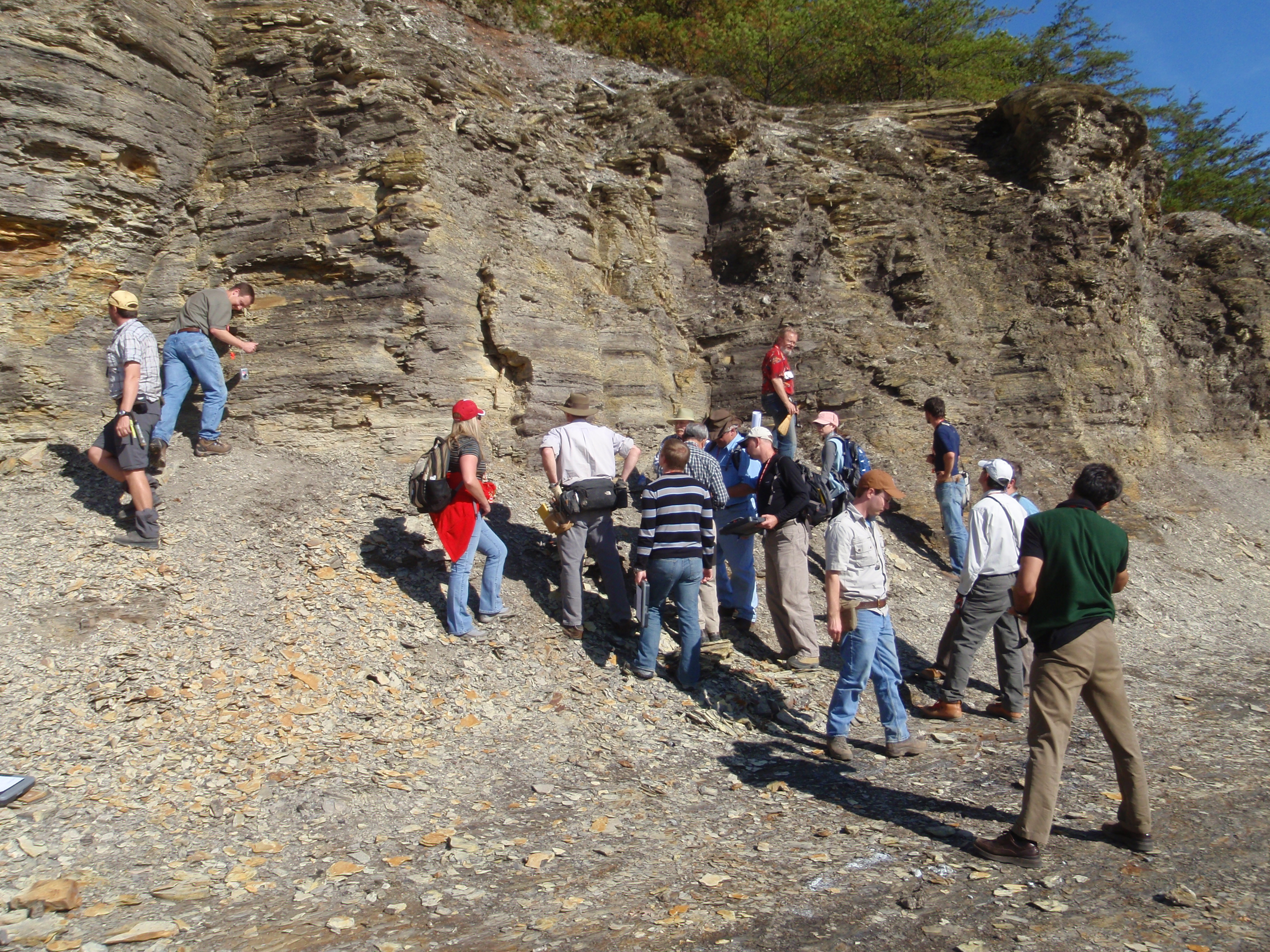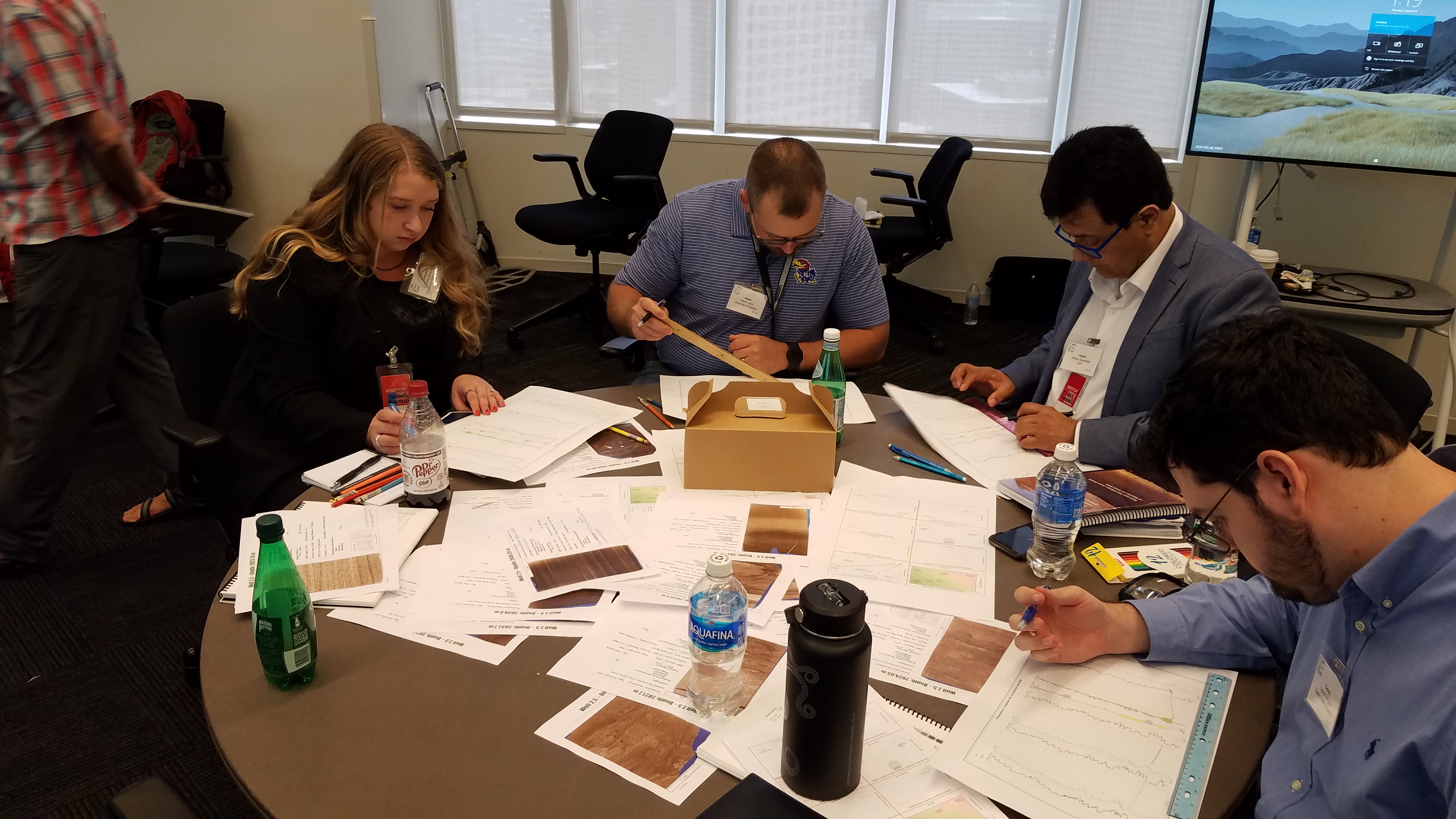Registration and Schedule
The workshop starts in the field in central Kentucky. Exceptional Paleozoic shale and tight-rock outcrops between Lexington and Louisville provide superb opportunities to study the stratigraphy, facies, mechanical properties, and heterogeneity of mudstones applicable to unconventional depositional systems from Exploration to Development scale. The workshop concludes on campus at Indiana University where participants will observe SEM analyses and sedimentology experiments with mud flumes that produce geologic features observed in shale and tight rocks. Participants will work as teams on a capstone project to integrate all lessons from previous days using seismic, well-log, core, and analytical data. Examples considered include Paleozoic to Cenozoic units: the New Albany, Marcellus, and Ohio shales, Spraberry-Wolfcamp formations, Woodford Shale, Eagle Ford Formation, Kimmeridge Clay Formation, Vaca Muerta Formation, Kingak Formation, Mowry Shale, and Monterey Formation.
Registration A maximum of 35 people can attend this workshop. Registration Fees: $1400 Professional (SEPM Member) $1600 Professional (Non-Member) and $700 Student (SEPM Member - Only 4 spots available) If you are a student and not a member of SEPM, please join for $15 (includes dues and online access). Registration includes: - All transportation from Lexington, KY to Bloomington, IN and to the Indianapolis Airport. Attendees must take care of their own transportation to Lexington, KY
- All breakfasts, lunches, and field drinks and snacks
- All exercise materials
- Field Guidebook
- SEPM Concepts in Sedimentology & Paleontology # 12 - Mudstone Primer
- Room blocks with special rates are secured at the Origin Hotel, Lexington, KY and the Graduate hotel in Bloomington, IN - registrants are responsible for their own reservations and hotel expenses as well as dinners.
Itinerary - Day 1 (Monday September 22)
- Workshop begins at 12:00 pm EST in Origin Hotel Conference Center (Lunch will be served)
- Class Introductions
- Name – Organization – Position – What Course Objectives you are looking for?
- Health and Safety for the Field Workshop
- Overview of Workshop
- Overview of Workshop and Data Coverage
- Spectrum of Shale & Tight Reservoirs
- Sequence Stratigraphy: Mudstone Sequence Stratigraphy and Energy Applications as Source, Reservoir, and Seal
- Exercise 1 (Group Exercise) Exploration-scale Sequence Stratigraphy (Regional Transecta for Vaca Muerta and Ohio Shale Comparison)
- Introduce key concepts on reservoir quality in delta front and shelfal mud-dominated systems (examples for Mancos/Niobrara/Pierre, Vaca Muerta)
- Mudstone Facies, Laminae to Bedsets
- Mudstone Families
- Geologic Overview and represented analogs (Vaca Muerta, Duvernay, Eagle Ford, Woodford, Mancos/Niobrara/Pierre, Mowry)
- Day 2 (Tuesday September 23)
- Workshop begins at 7:45 am EST (Breakfast provided at 7:00 am EST)
- Overview of Day 1
- Leave for field (8:30 am with boxed lunches)
- Stop 1: I-64 Morehead Kentucky (arrive by 9:30 am, 60 min) – Ohio Shale Overview stop, Identify Key Intervals with optimal Rock Quality using First Principles (Composition, Organic-richness, biogenic quartz, mechanical properties), drilling (carbonate concretions/beef/’butter shale’) and well-bore stability (high clay) risks, spatial prediction through building conceptual models for Depositional Environments.
- Stop 2: Grandkids Way (arrive by 10:45 am, 30 min) – 3D view of a Landing-zone, vertical vs spatial heterogeneity in distal prodelta/offshore organic-rich mudstones, Beef and implications for maximum effective stress (vertical vs horizontal), drilling orientations to maximize induced fracture space while avoiding FDI/stress shadowing
- Stop 3: Ridgeview Rd (arrive by 11:20 am, 30 min) – Devonian —Mississippian contact, Climate Change and superposition of shallow marine (lower delta front) above distal organic-rich biosiliceous mudstones (sequence stratigraphic implications), Assess hydrocarbon play elements, opportunities for Stratigraphic Traps, Mechanisms for rapid basinal shift in facies, how can we test working hypotheses?
- Lunch/Biobreak at 12:00pm EST at Walmart, (Stop 4) Granite Dropstone with natural fractures walking on bedding planes of Cleveland Shale, or panoramic view of Cave Run Lake
- Stop 5: Exit 133 801 Farmers Sharkey (arrive by 1:00, 1 min) Drive-by geology of Devonian – Mississippian Contact and Delta Front deposits of the Borden (Stratigraphic Traps, delta lobes analog to Wolfcamp XYZ and Bone Spring)
- Stop 6: I-64 (arrive by 1:05 pm, 30 min) Cleveland Shale and 3 Lick Bed exercise, measured section and TOC/Mineralogy relationships
- Stop 7: Irvine Baptist Church (arrive by 2:45 pm, 75 min) Log to Core to Outcrop characterization (Landing-zone optimization, basis of design (single-bench or multi-bench development)). Vertical stacking of carbonate channel elements intersecting shales with 10-15% TOC (discuss other shale & tight analogs), Mechanical stratigraphy and natural fracture development, heterogeneity, mass wasting, influence on stress of overburden and underburden (Duvernay and Eagle Ford discussion). Use STAC examples of drilling risks associated with carbonates (vibration data, detrital carbonates vs. carbonate concretions, Mass Transports and slumps, etc)
- Stop 8: Dollar General (arriving 4:10 pm, 20 min) 3 Lick Bed measured section (cycles decrease thickness laterally, implications for bedload transport vs eolian/suspension settling and TOC)
- Return to hotel (Lexington KY) (travel time ca. 1 hour; arrive 5:30 pm)
- Day 3 (Wednesday September 24)
- Workshop begins at 7:45 am EST (Breakfast starts at 7:00 am EST, checking out of Origin Hotel)
- Overview of Day 2
- Lecture to set up Day 3 Field Stops (Prodelta to Distal Condensed Section)
- Safety
- Geologic Overview and represented analogs (Vaca Muerta Bottomsets, Duvernay, Eagle Ford, Marcellus, Woodford, Mancos/Niobrara/Pierre, Mowry)
- Regional Sequence Stratigraphy (Eagle Ford, Woodford, Marcellus)
- Introduce key concepts on reservoir quality in offshore condensed sections for self-sourced and hybrid Shale and Tight plays
- Leave for field (Leave by 8:30 am with Boxed Lunches
- Stop 9: Junction City 1 (arrive by 9:30 am, 60 min) to assess lateral variability associated with sequence boundaries, clinothems, implications for drilling windows and MWD with inclined bedding, variable-energy deposition of organic-rich shales.
- Stop 10: Junction City 2 (arrive by 10:35 pm, 15 min) 3 Lick Bed measured section (continued condensation observed indicating strong lateral contribution of sediment transport across the continent)
- Lunch at Bernheim Forest State Park (arrive at 12:15 pm, 75 min)
- Stop 11: I-65 Bernheim Forest Exit Ramp (arrive by 1:45 pm, 60 min) stratal thickening associated with underlying carbonate platform (karst)
- Stop 12: Shepherdsville (arrive by 3:00 pm, 45 min) Devonian – Mississippian sb (distal expression of sequence boundary from previous day >200 kms away), utilize sequence stratigraphy to validate observations. Discussion of Mississippian Maury Formation, extremely clay rich, how would this be drilling through? Risks with casing? Borehole stability?
- Stop 13: Falls of the Ohio (arrive by 4:00 pm, 45 min) Stable platform carbonates of North Vernon/Jeffersonville (Middle Devonian), perfect expression of the “calm before the storm”, underlying fracture barrier analogous to Onondaga/Marcellus, Utica/Trenton, Eagle Ford/Buda, Niobrara/Fort Hays, Duvernay/Leduc, environmental implications prior to Acadian Orogeny
- Travel to Indiana University to stay at Graduate Hotel (travel time ca. 2 hours; arrive by 7:00 pm EST)
- Day 4 (Thursday September 25)
- Digital Analogs using drone models to show Chattanooga and Woodford Shale outcrops of Tennessee/Arkansas/Texas (map out the same stratigraphic zones >1500 miles, Distal condensed source intervals with overlying and underlying carbonate platforms)
- Discuss Proximal-Distal observations to set up capstone exercise, how can we use these relationships to predict in areas with minimal data?
- Flume Experiments throughout the day (clay/silt/sand/carbonate mud erosion and deposition)
- Shale & Tight Exploration exercise
- Day 5 (Friday September 26)
- Morning Report outs from each group, concluding remarks
- Shuttle to Indianapolis International airport, departure at 10:30am for afternoon flights
|







